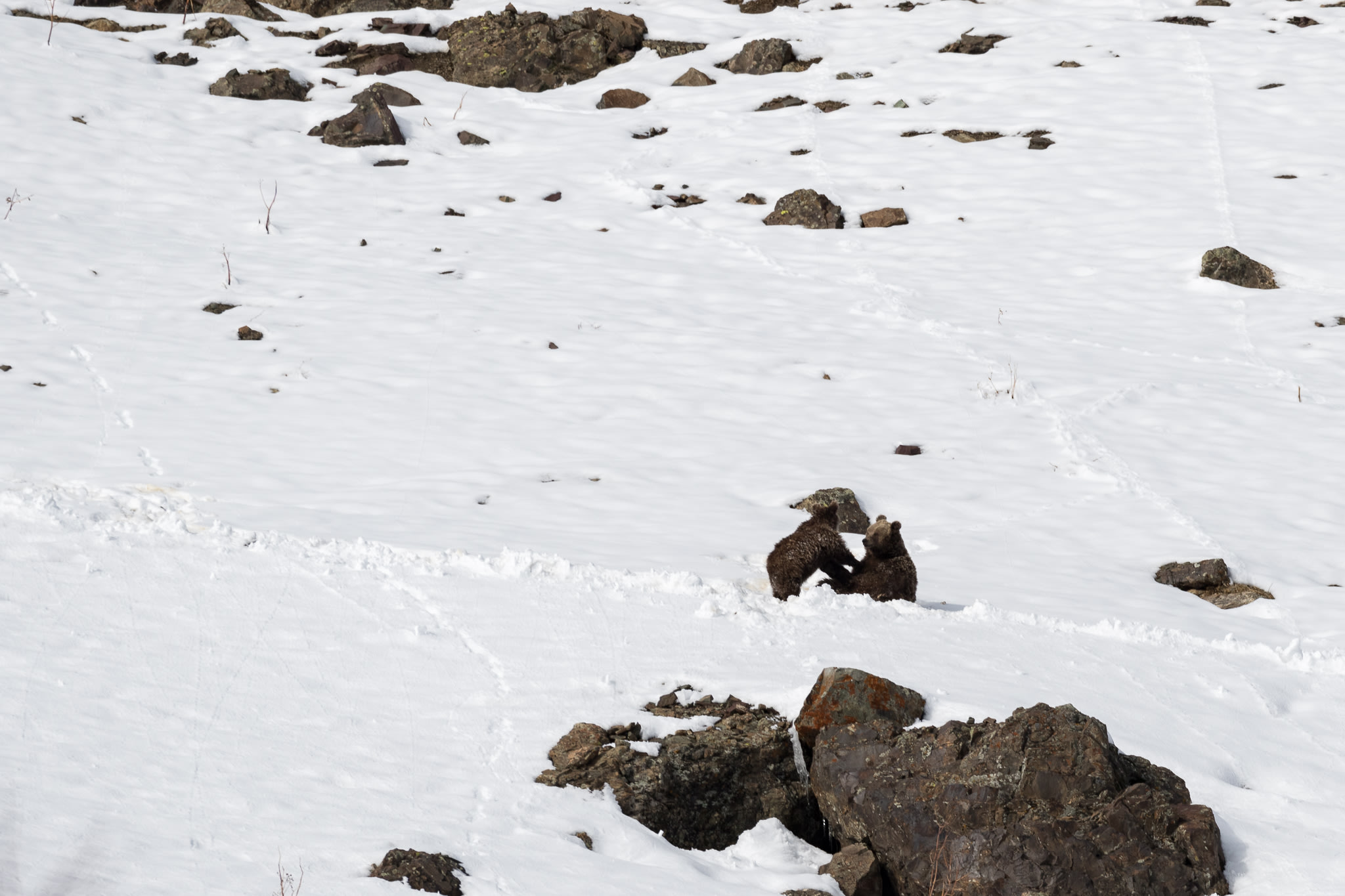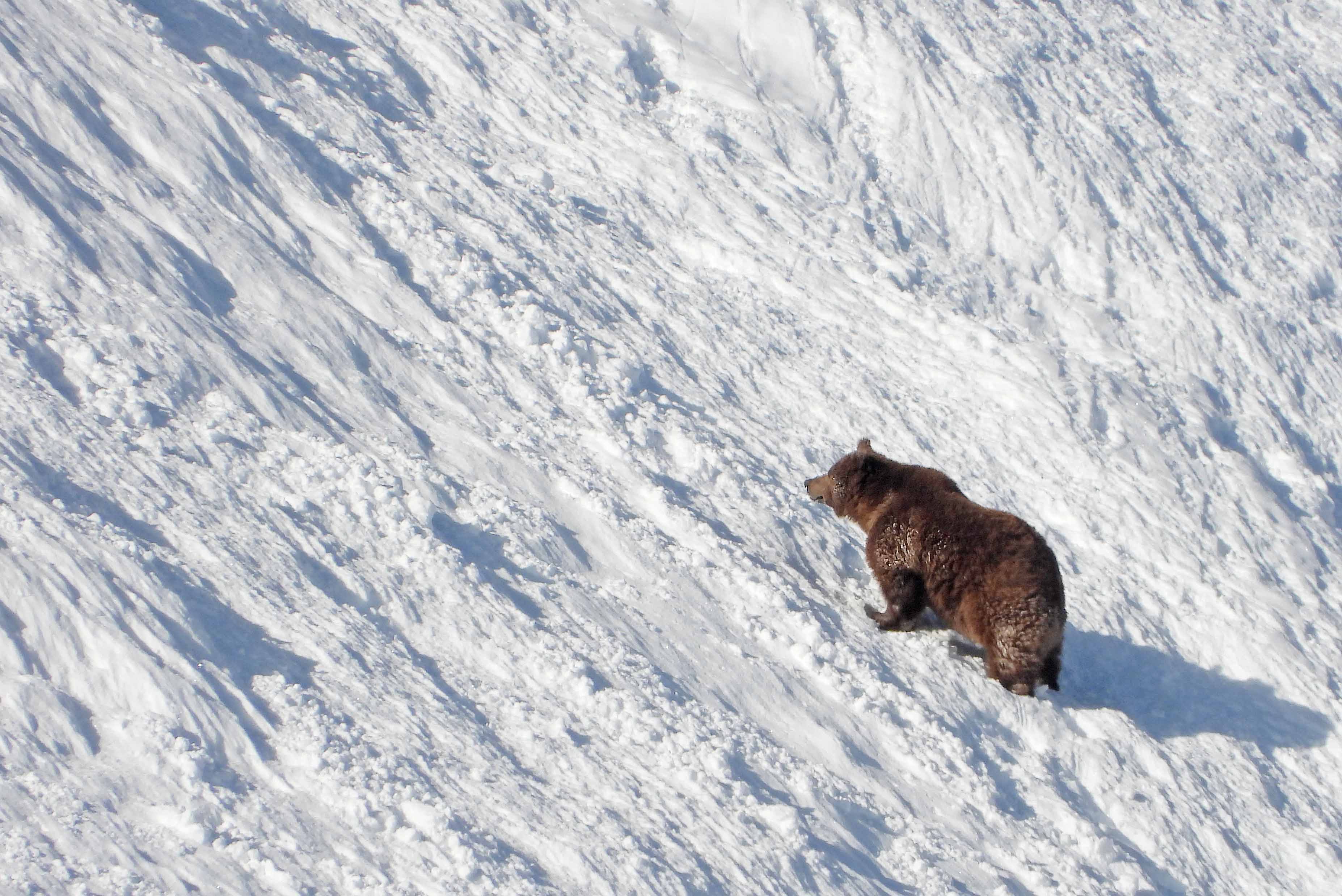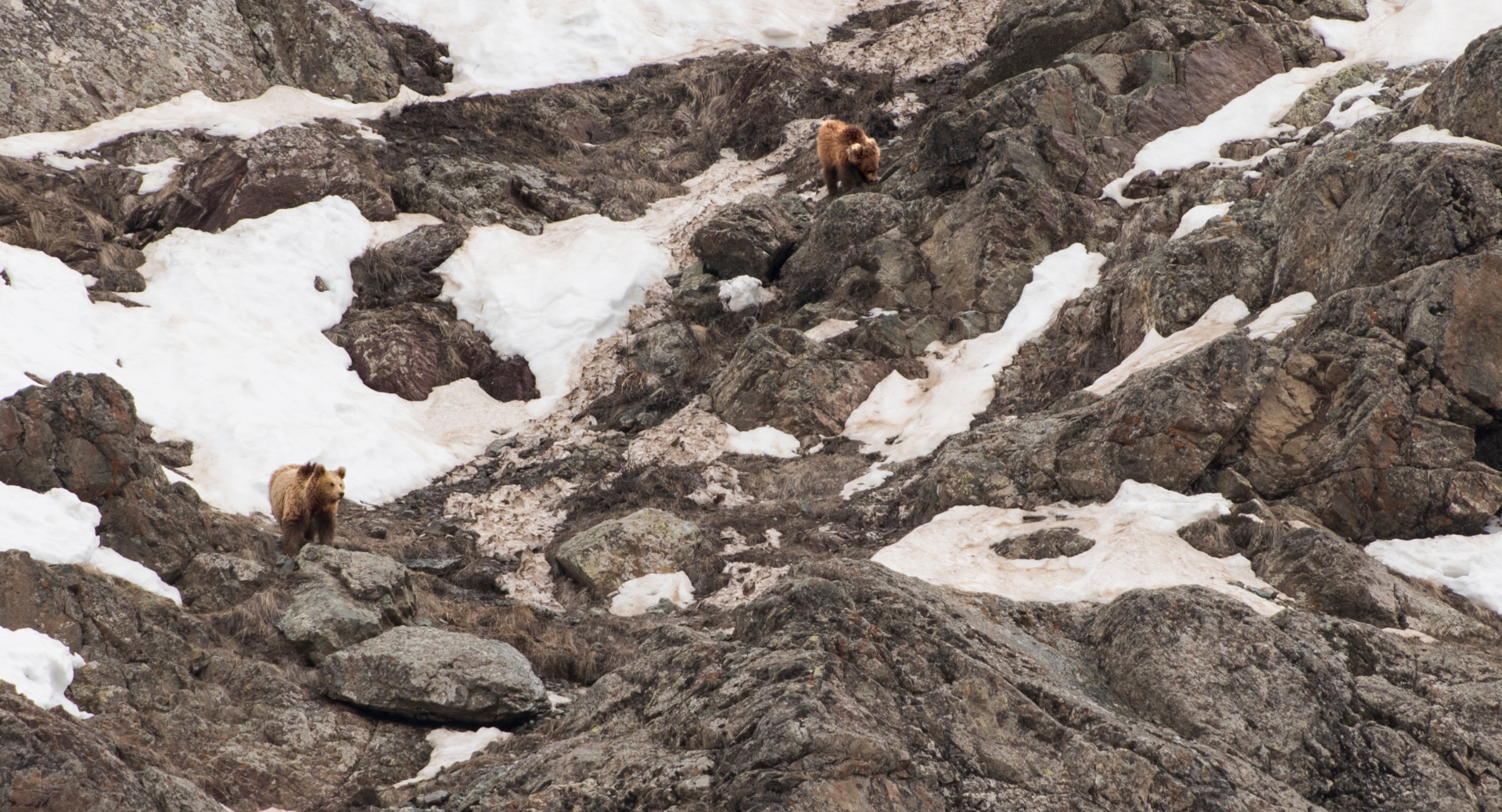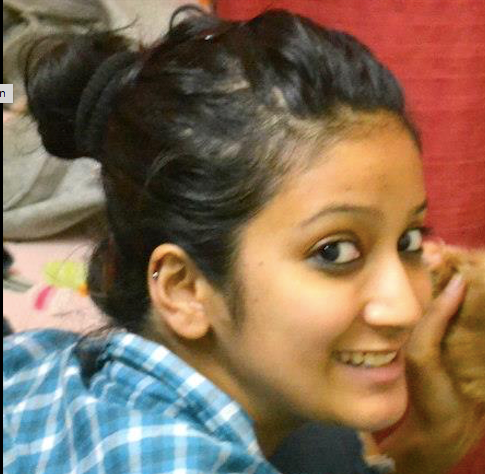“Dren-mo, dren-mo,” squealed an elated little boy as he ran ahead of us. “Please dear god, let this be real,” I prayed between huffs as I tried to keep up with Zarir, my six-year-old navigator. Progeny of the mountains, the imp cantered effortlessly through ankle-deep snow. He stopped at the edge of a climb, and pointed at the slope that rolled up in the distance. “Dren-mo” he repeated with great promise. Squinting under the glare of the silvery white snow, I trained my eyes on the boulders that dotted the slope. Even with my naked eye, I could see a lumbering shape move through the rocks.
Not wasting any more time, I clambered up the hill to where three members of my team had already set up cameras. Wildlife photographer Ghanesh was stretched out in the snow with his camera, his face taut with concentration. The director of our expedition, Eshika Fyzee, smiled and beckoned me to the spotting scope. The excitement was palpable. I took a breath, and dived in.
An enormous body of reddish-brown fur and stocky limbs supported a strikingly large head, set with small beady eyes. There it was — the rarest of bears in India, the dren-mo or Himalayan brown bear (Ursus arctos isabellinus). It sniffed around and pawed at what looked like a clump of plant roots. Before I could take a breath, another shape, much smaller, plodded out from behind the rocks. A cub! It tumbled through the snow and joined its mother in her investigation of the roots. The mother-cub duo seemed oblivious to their audience and the emotions they had inspired.
Overwhelmed, I moved away from the scope. Muzammil, our spotter from Kargil chuckled with satisfaction. “Look how fat they are. It is because of the winters that they eat as much and build up fat to survive” he said. Understandable, since it was December, the peak of winter and we were in Dras, where winter temperatures can drop to -45 degrees C.

Mother and cub play in the snowy mountains of Dras. The Himalayan brown bear is usually a solitary animal with the exception of a mating pair or a mother bear and her cubs. Photo: Ghaneshwaran Balachandran Cover: Himalayan brown bears feed on grasses, roots, fruits, berries, and small mammals like marmots. When food is sparse, bears have been known to prey on small goats and sheep as well. Photo: Karamjeet Singh
Dras, a town in the Kargil district of Jammu and Kashmir, infamous for being the coldest place in India is also one of the last known strongholds of the Himalayan brown bear in the country.
A subspecies of the brown bear, the Himalayan brown bear (Ursus arctos isabellinus), occupies the higher reaches of the Himalayas in India, Pakistan, Nepal, China, and Bhutan. In India, this species exists in small isolated populations in the fragmented alpine and subalpine habitats of Jammu and Kashmir, Himachal Pradesh, and Uttarakhand. Their potential habitat range in India is estimated at 4,300 square kilometres out of which very little is protected.
Very little is known about these elusive bears, which coincidentally belong to one of the most ancient brown bear lineages. Dr Bipin Chandra Rathore, who has been conducting extensive research on the species, writes that the occurrence of brown bears in India dates back to the 19th century. It was not uncommon for the hill folk to spot the ‘bhrubbu’ — the colloquial term for brown bears then — feeding on the grassy plains in the morning.
Even as we stood watching the bears from our vantage point, the mother raised her head slightly to sniff the air, only to quickly go back to the root she had been feeding on. I turned to the scope again and watched the little cub mock charge its mother. The cub will stay with its mother till it reaches the age of two or two-and-a-half, after which it will turn solitary.

Himalayan brown bears have been known to go into a feeding frenzy before peak winter to build up fat and energy reserves for their hibernation. Photo: Surya Ramachandran
Omnivorous in nature, they feed on the sparse herbaceous vegetation that high altitudes offer, often supplementing their diet with small mammals like marmots or pikas. However, habitat degradation and depleting sources of food have pushed these bears into human settlements. The locals tell me that while bears have been around for quite some time, incidents of them breaking into villages and homes have now come to the fore. “Just last April, a bear had broken into a shepherd’s house and killed his livestock,” says Muzammil. “Sometimes even our barricades don’t work. These bears are not just strong, they are also very smart,” a lady from the village pipes in. I wasn’t surprised that they could find their way around village houses, given their powerful claws and natural digging instinct.
“There is another problem that is very specific to Kargil,” interjects Muzammil. “This region is scattered with army camps. These camps leave their food waste out in huge heaps, which then attract bears. Not that the army is at fault here, waste management in such remote areas becomes a problem, but the situation cannot be ignored,” he says.
As humans and bears compete for space and resources, conflict too increases. Herders and villagers, who lose their livestock to bears, then indulge in retaliatory killings, pushing a population already in decline to its brink. In Himachal Pradesh, the Himalayan brown bear is losing its habitat to deforestation and commercial harvesting of trees. The threat of poaching too looms large, driven by an expanding international demand for bear fur, claws, and internal organs for medicines.
Not much is known of their ecology or behaviour, as studies on the species have been few and infrequent due to their remote habitat. Geopolitical tensions between India and Pakistan too have prevented cross-border studies.
Niyaz Khan, a scholar with the Wildlife Institute of India is one of the few researchers studying the Himalayan brown bear. “Even locals have observed a change in the behaviour of these animals. The bears go into hibernation around October only to emerge from their dens in April or May. But here, we have been spotting bears all year round,” he says.

The Himalayan brown bear population in India is estimated at less than 500 individuals. Without concerted conservation efforts this keystone species faces the threat of extinction, exacerbated by rampant habitat destruction, human-animal conflict and poaching. Photo: Karamjeet Singh
While no definite conclusion can be drawn yet, one of the reasons for this change in denning patterns, Muzammil believes, could be attributed to climate change. With higher altitude regions experiencing shorter winters, it is possible that the bears’ hibernation cycles too may have become briefer. Therefore instead of hibernating in their dens, the bears take to snowy hills and often descend into the valleys in search of food.
Although Muzammil’s theory is not supported by any scientific data, future studies will have to factor in climate change, since Himalayan ecosystems are particularly susceptible to changing temperatures and its effects here are magnified.
A small commotion in the crowd that had assembled around us broke our conversation. We instinctively looked towards the bears. The mother bear had drawn herself up to her full height and was standing on her hind legs. Common belief goes that the bears’ ability to walk upright is what gave rise to the legend of the Yeti or the abominable snowman.
I could not help but notice the irony. Here was this majestic keystone species of the Himalayas, unknown to mainland India, tethered to the edge of extinction. Though IUCN places the species in the ‘Least Concern’ category worldwide, in India the estimated population of brown bears is as low as 500 individuals. Despite being included in Schedule 1 of the Indian Wildlife Protection Act, no intensive effort has been made towards its conservation. In a few years the Himalayan brown bear could go from the reality of being a rare species to being a figment of the imagination.
I had one last look at the mother-cub duo, now moving up the mountain. Zarir, the little six-year-old navigator who had led me to my team was standing right next to me, observing quietly. He gave me a disarming smile, turned towards the bears and raised his arm in farewell, “Bye-bye dren-mo,” he said. “Come again.”
